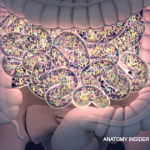L. reuteri Exacerbates Symptoms
To establish if L. reuteri exacerbates lupus-related symptoms, L. reuteri or L. johnsonii tissue isolates were introduced into the stomachs of germ-free mice, which were then treated with imiquimod. Those treated and given L. reuteri developed spleen and liver symptoms and increased type 1 IFN expression compared with media alone or exposure to the other strain. L. reuteri exposure also increased gut permeability.
Because ingestion of these bacteria was sufficient to exacerbate SLE symptoms, the researchers investigated if L. reuteri alone drives systemic autoimmunity. They monocolonized young, germ-free mice with L. reuteri, treated them with imiquimod and examined them 10 weeks later. The mice developed splenomegaly and hepatomegaly and systemic type 1 IFN expression. These responses were not seen in monocolonization with an unrelated gut bacterium. The L. reuteri monocolonized group also accumulated more plasmacytoid dendritic cells than those in the unrelated bacterium group.
“The second part of our research looks at a resistant-starch diet and how that impacts on the microbiome and, in turn, on SLE-related mortality,” says Dr. Kriegel. Resistant starch is a carbohydrate that resists digestion in the small intestine and ferments in the large intestine. Colonic fermentation produces short-chain fatty acids, which are key mediators of gut microbiota. “The critical question was if we can change the gut microbes and, thus, the course of the disease.”
Impact of Diet

Dr. Perl
The researchers isolated fecal pellets of TLR7 transgenic mice fed a resistant-starch diet and performed bacterial DNA sequencing. L. reuteri was decreased in the mice fed a resistant-starch diet compared with controls fed a standard diet. Neither microbial diversity nor composition was significantly impacted by a resistant-starch diet. However, introduction of a resistant-starch diet decreased bacterial translocation, increased markers of gut integrity and prevented functional leakiness.
When continually feeding a resistant-starch diet to TLR7 transgenic mice and following them over half a year, the researchers found a significant survival advantage compared with the control group. When given to wild-type mice with induced lupus, a resistant-starch diet resulted in less organomegaly. Systemic type 1 IFN also normalized in both the inducible and the TRL7 transgenic model. A resistant-starch diet decreased expression of proinflammatory molecules in the spleen and gut, suggesting a systemic anti-inflammatory effect.
Short-Chain Fatty Acid Protective
The main metabolites from resistant-starch fermentation are the short-chain fatty acids acetate, propionate and butyrate. DNA sequencing from TLR7 transgenic mice fed a resistant-starch diet showed an increase in bacteria taxa capable of fermenting resistant starch, including Clostridiales that were lacking in control-fed mice. Sequencing of fecal microbiomes from SLE patients showed a reduced abundance of Clostridiales in a subgroup (enriched with lactobacilli) as seen in lupus-prone mice. The researchers found a similar imbalance between Clostridia and Lactobacillus in SLE patients, but have not yet intervened with their diets.
The researchers supplied short-chain fatty acids to the drinking water of TLR7 transgenic mice and those monocolonized with L. reuteri and treated with imiquimod. L. reuteri-induced effects were mitigated in both by short-chain fatty acid administration. Hepatosplenomegaly, plasmacytoid dendritic cell numbers in the spleen and lymph nodes, as well as proteinuria were suppressed to levels seen in wild-type mice.
“The resistant-starch diet is a protective mechanism,” says Dr. Kriegel. “In the models we studied, we can change the gut microbes and, thereby, change the course of the disease. We do not know yet if this diet would also work in patients, but we now better understand the baseline microbiome of SLE patients.”


